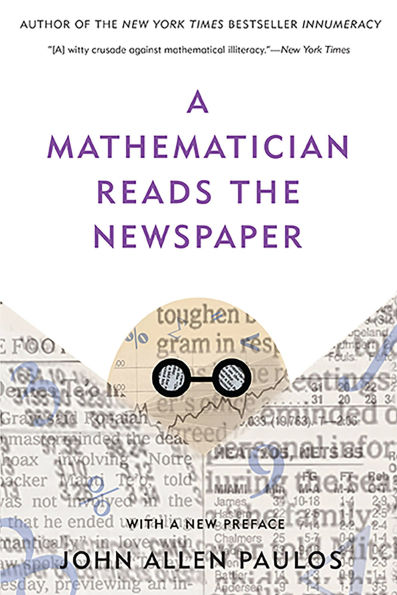A Mathematician Reads the Newspaper
John Allen Paulos is a master at shedding mathematical lights on our everyday world:What exactly did Lani Guinier say about quotas? What is the probability of identifying a murderer through DNA testing? Which are the real risks to our health and which the phony ones? Employing the same fun-filled, user-friendly, and quirkily insightful approach that put Innumeracy on best-seller lists, Paulos now leads us through the pages of the daily newspaper, revealing the hidden mathematical angles of countless articles. From the Senate, the SATs, and sex to crime, celebrities, and cults, Paulos takes stories that may not seem to involve mathematics at all and demonstrates how mathematical naïtéan put readers at a distinct disadvantage.Whether he's using chaos theory to puncture economic and environmental predictions, applying logic and self-reference to clarify the hazards of spin doctoring and news compression, or employing arithmetic and common sense to give us a novel perspective on greed and relationships, Paulos never fails to entertain and enlighten.Even if you hated math in school, you'll love the numerical vignettes in this book.
1000285396
A Mathematician Reads the Newspaper
John Allen Paulos is a master at shedding mathematical lights on our everyday world:What exactly did Lani Guinier say about quotas? What is the probability of identifying a murderer through DNA testing? Which are the real risks to our health and which the phony ones? Employing the same fun-filled, user-friendly, and quirkily insightful approach that put Innumeracy on best-seller lists, Paulos now leads us through the pages of the daily newspaper, revealing the hidden mathematical angles of countless articles. From the Senate, the SATs, and sex to crime, celebrities, and cults, Paulos takes stories that may not seem to involve mathematics at all and demonstrates how mathematical naïtéan put readers at a distinct disadvantage.Whether he's using chaos theory to puncture economic and environmental predictions, applying logic and self-reference to clarify the hazards of spin doctoring and news compression, or employing arithmetic and common sense to give us a novel perspective on greed and relationships, Paulos never fails to entertain and enlighten.Even if you hated math in school, you'll love the numerical vignettes in this book.
16.99
In Stock
5
1

A Mathematician Reads the Newspaper
240
A Mathematician Reads the Newspaper
240Paperback(First Trade Paper Edition)
$16.99
16.99
In Stock

Product Details
| ISBN-13: | 9780465089994 |
|---|---|
| Publisher: | Basic Books |
| Publication date: | 09/10/2013 |
| Edition description: | First Trade Paper Edition |
| Pages: | 240 |
| Product dimensions: | 5.50(w) x 8.20(h) x 0.70(d) |
About the Author
From the B&N Reads Blog
